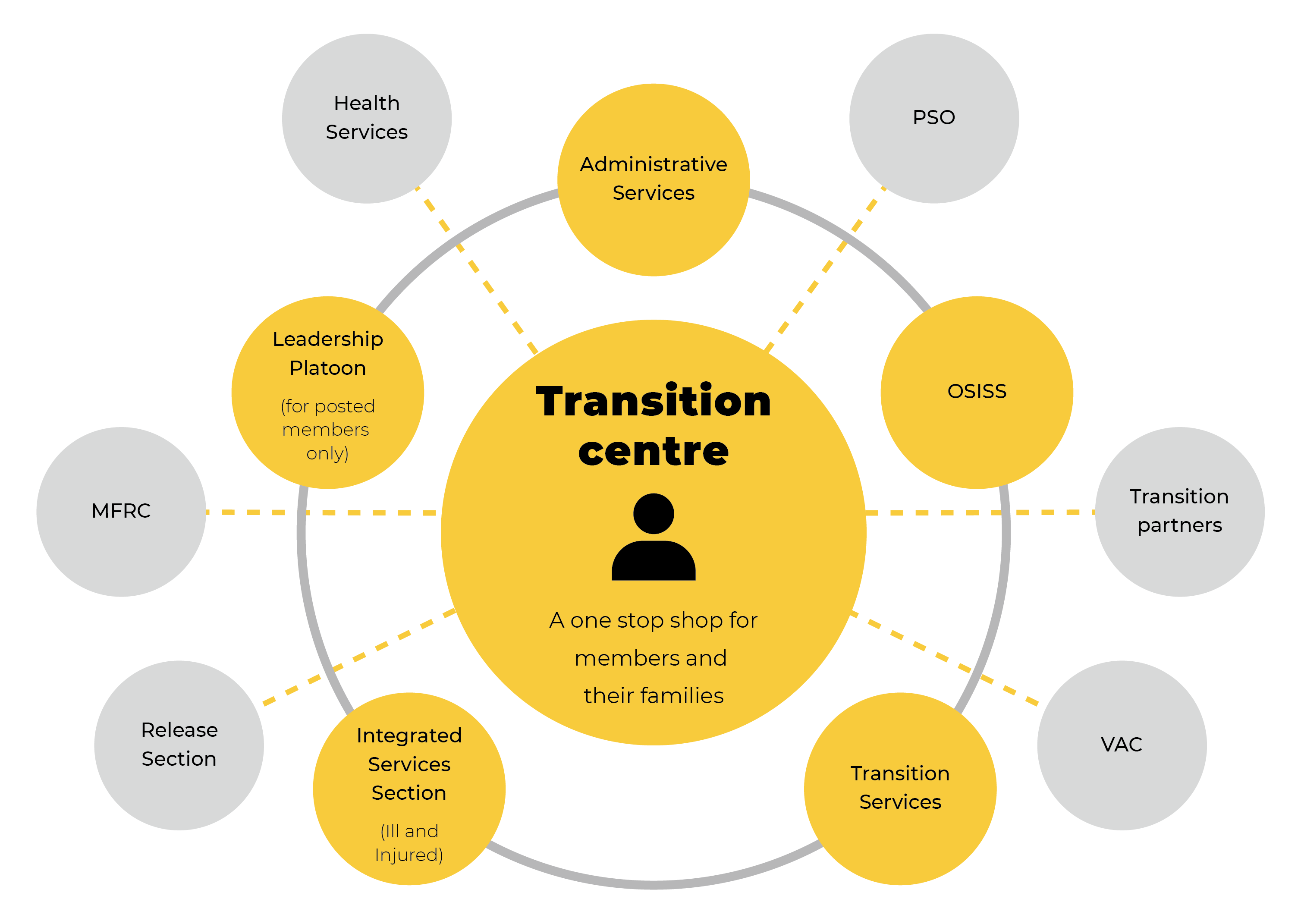Introduction to the Canadian Armed Forces Transition Group
The mission of the Canadian Armed Forces Transition Group (CAF TG) is to deliver personalized, professional, and standardized casualty support and transition services to CAF members and their families to enable a seamless transition and enhanced well-being, with special attention provided to ill and injured personnel, their families and the families of the deceased. CAF TG is a Level 2 formation reporting directly to the Chief of Military Personnel (CMP) and is responsible for the transition needs of all CAF members, while providing care for all personnel posted to, or part of, the formation.
CAF TG headquarters (HQ) is located in Ottawa, with nine regional Transition Units (TU) and 26 Transition Centres (TC) offering transition services located across the country. TCs are integrated, one-stop centres where all CAF members and their families, regardless of whether they are medically or non-medically released are offered transition services and release administrative support. These TCs, staffed by members from CAF/DND, VAC and our numerous partners, will offer personalized, professional, and standardized transition services to all CAF members, Veterans, and their families to inform, prepare, and empower them as they navigate toward life after service.
Essentially, the role of CAF TG is to provide education and training on transition so that CAF members can explore all options available to them. Members are encouraged to start planning for post-military life early in their careers. This will help members optimize their careers, while improving transition readiness.
Canadian Armed Forces Transition Centre (CAF TC)
There are important support mechanisms in place for CAF personnel, including the existence of a CAF TC that focuses on their needs.
One of the many services that a CAF TC provides is retention and transition support and programs to both non-medically releasing and ill and injured Reg F and Res F CAF members. CAF members do not have to be posted to a CAF TC to receive the services available.
CAF TC has four main components: a Services Section, a Support Platoon, a transition team, and Partner Organizations. The strength of service delivery is achieved by all service partners working collaboratively as a team.

Description of the figure
This image illustrates the main structure of a Transition Centre with the key partners who can support you throughout your transition process leading to your release.
Transition Centre – A one stop shop for members and their families
Services:
- Administrative Services
- OSISS
- Transition services
- Integrated Services Section (Ill and Injured)
- Leadership Platoon (for posted members only)
Partners:
- Health Services
- PSO
- Transition partners
- VAC
- Release Section
- MFRC
- CAF TC Services Section: Service Coordinators (SCs) support members who are likely to face a medical release. Core services include:
- Return to Duty coordination;
- Vocational transition assistance;
- Home and vehicle modifications;
- Information, support, and advocacy services for casualty administration, benefits, and programs; and
- Administrative support to families of CAF members who die while in service, including the disengagement of the Designated Assistant.
- CAF TC Support Platoon: Ill and injured CAF members may be posted to the TC based on the recommendation of the unit CO and medical authority where they are under command of the nearest CAF TC Support Platoon. While some members posted to the centre may eventually be released due to their medical condition, the primary objective of the CAF TC is to provide support to the member throughout their recovery and enhance a return to duty in the CAF.
- CAF TC Transition Services: Transition Advisors (TAs), Family Transition Advisors (FTAs), Release Administrators (RAs), Transition Personnel Selection Officers (TPSOs) and Transition Trainers (TTs) will work with all releasing members to provide personalized guided support to ensure a successful transition to post-military life.
- CAF TC Service Partners: Some Partner Organizations are co-located in the TC for currently serving and former CAF members, as well as their families, and facilitates one-stop service for a majority of their requirements. Key partners associated with CAF TC include:
- VAC;
- SISIP;
- Family Liaison Officers and FTAs;
- Canadian Forces Health Services (CFHS); and
- Base and Wing partners (PSO, Chaplain, Military Family Resource Centre (MFRC), etc.)
CAF TC SCs work closely with CFHS Nurse Case Managers, CAF Vocational Rehabilitation Program (VRP) Counsellors, VAC Case Managers, and other partner agencies to ensure a comprehensive and multi-disciplinary approach.
For additional information on various benefits, programs and services offered by CAF TG and others for serving and former CAF members and their families, call or visit your local TC.
All Regular and Reserve Force transitioning members will follow a chain of command (CoC) implemented process that is detailed in the Initial Transition Process section of the next chapter, entitled Introduction to Transition.
In addition to this Initial Transition Process, CAF TG has also developed and implemented several services and tools to support transitioning members and their families. These services include:
- Digital Transition Centre (DTC) Portal on Canada.ca; My Transition 101 (MT 101) available through Defence Learning Network (DLN);
- Military Occupational Structure Identification Code (MOSID)/ National Occupation Code (NOC) Equivalency Tool (MNET);
- My Skills and Education Translator (MySET);
- My Transition Seminars and workshops (formerly called SCAN), both virtual and in person;
- Long-Term Planning (LTP) Seminars; and
- Policies related to transition services for all CAF members, and for casualty support to the ill and injured members.
This guide is a first step towards providing transitioning members1 and their CoC with comprehensive guidance regarding transition. In addition, this document will also provide members and their families with transition specific checklists, templates and links to assist with the transition from military to civilian life.
For additional information, visit the Military Career Transition webpage.